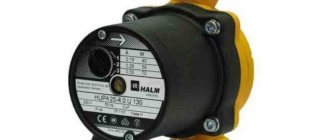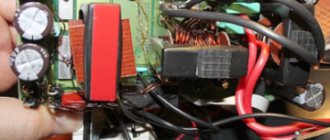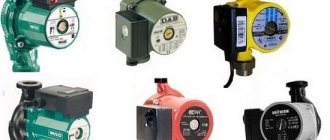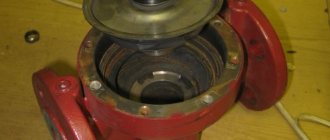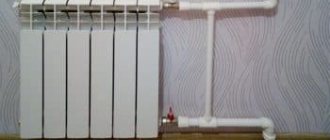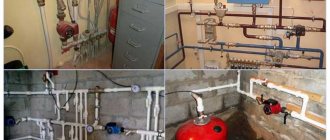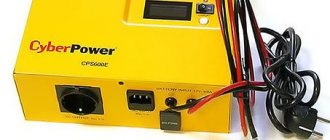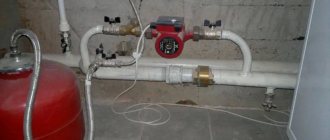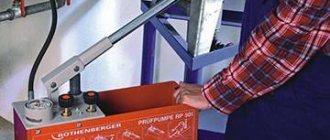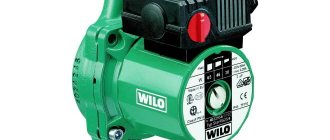Centrifugal network pumps are used to circulate water in hot water supply and heating systems, as well as to maintain the boiler installation. For high flow rates, units with an impeller with a two-way liquid supply driven by an electric motor are used; for low flow rates, centrifugal pumps are used with the suction and pressure pipes arranged “in line”. The working parts can be made of steel and gray cast iron, so the pump is characterized by a safety margin and long-term trouble-free operation. By design, the units can be used for pumping clean water and liquids with similar properties. The advantage of the Corvette Group pumps is their high efficiency, simplicity and reliability in operation, as well as the ability to adjust the pressure in the pipeline.
Maintenance and repair of the circulation pump
In a forced circulation heating system, the heart is the circulation pump.
The presence of heating and its quality depend on its stable operation. The same applies to closed hot water supply systems with a constant flow of water in the pipes between the boiler and the storage tank. During operation, the question inevitably arises of how to service and repair the circulation pump so that it continues to operate stably and without failure. For normal operation of the pump, the following measures must be taken:
- Correct operation taking into account all the rules established by the pumping equipment manufacturer.
- Pump prevention and maintenance.
- Diagnostics and repair in case of pump failure.
The more accurately the operating rules are followed and the more regularly the pump is serviced, the less often you will have to think about repairing or replacing it.
Where to put
It is recommended to install a circulation pump after the boiler, before the first branch, but on the supply or return pipeline it doesn’t matter. Modern units are made from materials that can withstand temperatures up to 100-115°C. There are few heating systems that work with a hotter coolant, so considerations of a more “comfortable” temperature are untenable, but if you feel safer, put it in the return line.
Can be installed in the return or direct pipeline after/before the boiler up to the first branch
There is no difference in hydraulics - the boiler, and the rest of the system; it makes absolutely no difference whether there is a pump in the supply or return branch. What matters is the correct installation, in terms of strapping, and the correct orientation of the rotor in space
Nothing else matters
There is one important point regarding the installation location. If the heating system has two separate branches - on the right and left wings of the house or on the first and second floor - it makes sense to install a separate unit on each, and not one common one - directly after the boiler. Moreover, the same rule remains on these branches: immediately after the boiler, before the first branch in this heating circuit. This will make it possible to set the required thermal conditions in each part of the house independently of the other, and also in two-story houses to save on heating. How? Due to the fact that the second floor is usually much warmer than the first floor and much less heat is required there. If there are two pumps in the branch that goes up, the speed of movement of the coolant is set much lower, and this allows you to burn less fuel, without compromising the comfort of living.
There are two types of heating systems - forced and natural circulation. Systems with forced circulation cannot work without a pump; systems with natural circulation work, but in this mode they have lower heat transfer. However, less heat is still much better than no heat at all, so in areas where electricity is often cut off, the system is designed as hydraulic (with natural circulation), and then a pump is installed into it. This gives high heating efficiency and reliability. It is clear that the installation of a circulation pump in these systems is different.
All heating systems with heated floors are forced - without a pump, the coolant will not pass through such large circuits
Forced circulation
Since a forced circulation heating system without a pump is inoperative, it is installed directly into the gap in the supply or return pipe (of your choice).
Most problems with the circulation pump arise due to the presence of mechanical impurities (sand, other abrasive particles) in the coolant. They can jam the impeller and stop the motor. Therefore, a mesh dirt filter must be placed in front of the unit.
Installing a circulation pump in a forced circulation system
It is also advisable to install ball valves on both sides. They will make it possible to replace or repair the device without draining the coolant from the system. Turn off the taps and remove the unit. Only that part of the water that was directly in this piece of the system is drained.
Natural circulation
The piping of the circulation pump in gravity systems has one significant difference - a bypass is required. This is a jumper that makes the system operational when the pump is not working. One ball shut-off valve is installed on the bypass, which is closed the entire time the pumping is running. In this mode, the system operates as forced.
Installation diagram of a circulation pump in a system with natural circulation
When the electricity goes out or the unit fails, the valve on the jumper is opened, the valve leading to the pump is closed, and the system operates as a gravity system.
Installation features
There is one important point, without which the installation of the circulation pump will require rework: it is necessary to rotate the rotor so that it is directed horizontally. The second point is the direction of flow. There is an arrow on the body indicating which direction the coolant should flow. This is how you turn the unit so that the direction of movement of the coolant is “in the direction of the arrow”.
The pump itself can be installed both horizontally and vertically, just when selecting a model, make sure that it can work in both positions. And one more thing: with a vertical arrangement, the power (pressure created) drops by about 30%. This must be taken into account when choosing a model.
Correct operation
A number of simple requirements apply to any circulation pump:
- Do not allow the pump to idle in the absence of water. Applies to both wet and dry pump types.
- The pump should not be allowed to operate with the water flow stopped, for example, if the valve before or after the pump is closed.
- The optimal operating mode should be determined taking into account the maximum and minimum throughput of the equipment.
- It is important to comply with the manufacturer’s requirements for the nominal water pressure in the system.
- The coolant temperature should not exceed 65°C. Therefore, the circulation pump is installed on the return line in front of the boiler, where the cooled water flows. When a given threshold is exceeded, the process of deposition of hardness salts on the internal surfaces of the pump accelerates many times over.
- Long periods of downtime should not be allowed. About once every month or two, it is advisable to turn on the pump for 15 minutes. If this is not done, then the risk of shaft jamming increases during the oxidation process.
- It is unacceptable to use a circulation pump to pump dirty water containing dense particles in suspension. A coarse filter must be installed, or the purity of the water or coolant is monitored in other ways.
In operating mode, the pump must have a uniform sound of the operating drive and a constant output pressure value, which is monitored by an installed pressure gauge. If handled well, even the simplest circulation pump can operate for up to 5 years until its main elements wear out.
Technical characteristics of pumps for heating systems GRUNDFOS UPS 25–40
The base of the device is made entirely of cast iron. The drive design is made according to the “wet rotor” scheme. Thanks to this type of pump assembly, it is almost silent. It operates at three speeds, they are usually set depending on your heating system (that is, individually everywhere). The model name marking is deciphered as follows:
- Up — equipment type designation;
- S—pump speed switch;
- 25 — pipe diameter, mm;
- 40 is the highest pressure indicator.
Such a circulation device is small in size, which is why it does not require additional work space. The pump is intended for water circulation in heating and floor heating systems, supplying hot water.
Device specifications:
- Pipe connection - G 1 1/2;
- The maximum recommended lift is 2.45 m;
- The diameter of the pipes is 25 mm;
- Pressure - up to 4 m;
- Total power - 25/35/45 W;
- Weight - 2.6 kg;
- The highest flow rate of the device is 3.5 m3/h;
- Installation length - 180 mm;
- Maximum operating pressure - 10 bar;
- Power supply - 230 V.
The circulation device is very economical: it can operate either continuously or by setting a timer that controls the entire process according to specified parameters.
Design
Almost all circulation pumps are centrifugal type. They have an impeller mounted on the motor shaft and placed in a special “shell” chamber. The entrance to the shell is located in the center, while the exit is the outer edge of the shell with a channel extending around the circumference in the direction of movement of the impeller. The engine spins the impeller, and water, under the influence of centripetal force, rushes from the center to the edges of the sink from inlet to outlet.
Pump structural elements:
- pump part, sink and impeller mounted on the shaft;
- electric motor;
- electronic control unit.
The most susceptible to wear is the moving part of the pump - the motor shaft and impeller, as well as the bearings on which they are mounted.
Prevention and Maintenance
Long service life and trouble-free operation are possible only if proper operating conditions and regular maintenance of the pump are observed. Maintenance means periodic inspection and cleaning of the pump. Inspection for abnormalities in operation should be carried out at least once a quarter, that is, twice during the heating season. It is advisable to perform cleaning every two to three years, depending on the quality of the water and the conditions in which the pump operates.
During the entire period of operation, it is advisable to periodically check the operation of the pump:
- Connections are checked for leaks. If identified, gaskets and seals (tow, FUM tape, etc.) are replaced.
- The presence and condition of grounding is visually checked.
- The sound of a running engine should not be accompanied by clangs, knocks, or extraneous sounds.
- The engine should not vibrate much.
- The pressure in the line is checked and its compliance with the nominal one.
- The housing must be clean and dry. If this is not the case, then you should carry out external cleaning, check the electronic unit for flooding and eliminate the reason why the pump is wet.
Troubleshooting
Based on how the pump operates, sound, vibration or changes in pressure, outlet pressure, it is necessary to accurately determine the malfunction and eliminate the cause.
| Symptom of malfunction | Probable Cause | Repair |
| The pump makes sounds after switching on, but the shaft does not rotate | Shaft oxidation due to prolonged inactivity | Unscrew the protective cap from the end of the shaft on the motor housing and manually turn the motor shaft using a slotted screwdriver. |
| Blocking by a foreign object | Disassemble the pump block with the impeller and clean it, check the condition of the coarse filter installed in front of the pump | |
| Power problems | Check the voltage rating in the network and correct the problem if necessary. | |
| After applying voltage, the pump does not start and does not make any sounds. | No actual voltage on power line | Check the power line and the condition of the circuit breakers |
| The fuse in the control unit has tripped | Replace fuse | |
| The pump turns off after a short period of operation | Limescale deposits in the stator cup | Clean the stator cup and motor rotor |
| Strong extraneous noise when the pump is running | Dry running, presence of air in pipes | Release the air. Drain the pump shell and fill with water. |
| Cavitation | Increase the pressure in the supply line. | |
| Pump vibration | Support bearing wear | Replacing bearings |
| Reduction of pressure and flow in comparison with the passport data | Abnormality in the power supply to the pump, phase change, resulting in a decrease in pump power or a change in the direction of rotation of the impeller | For three-phase motors, the quality of all phases is checked. For single-phase power supply, check the capacitor and replace if necessary |
| High hydraulic resistance of the circulation circuit | Check the filters, increase the cross-section of the pipes, check the condition of the shut-off valves. | |
| Triggering of external protection on the pump power line | Problems with the electrical part of the pump | Check the condition of the terminals for short circuits, check the capacitor and the control unit. Check the stator windings. Their resistance should not be lower than the rated value. |
Repair
It is best to take a broken circulation pump to a specialized service center, especially if it is still under warranty. Most of the models currently on the market, unfortunately, are non-separable or partially disassembled, so if problems arise with its internal spare parts, entire units or the pump assembly must be replaced. If the warranty period has already expired, and the design of the pump allows you to disassemble it and get to all the main components, then, if you have the appropriate skills, you can carry out the repair yourself.
Having determined the cause of the malfunction from the table above, it is enough to disassemble the pump, as indicated in the paragraph on prevention and maintenance, and replace the faulty part.
The main elements in the pump control unit are:
- 1-5 microfarad capacitor;
- terminal block for connection;
- speed controller.
Due to the small capacitance of the capacitor, you can check it using a multimeter, which has a built-in C-meter with a limit of up to 20 µF. If the readings deviate significantly from the nominal value, the capacitor should be replaced; it is important to maintain the polarity of the connection and be sure to have its voltage tolerance. For a conventional single-phase motor, capacitors with a tolerance of up to 450 V are used.
The speed controller assembly is replaced with a new one. It is enough to disconnect it from the terminals, remembering the position of each pin and connect a new one.
Popular models of circulation pumps are from the manufacturers Wilo, Ggrundfos, Dab. Not least due to their reliability. You can expect these pumps to break down within the warranty period only if the recommended operating conditions are violated. However, during the post-warranty period, Wilo often has problems with support bearings. Only replacing them helps.
Ggrundfos and Dab can “please” the impeller to become overgrown with scale for high-temperature heating systems, as well as silting of the stator cup. It is better to prevent these problems by installing a good filter and preparing the water. Otherwise, breakdowns are often justified by external problems.
Source of the article: https://udobnovdome.ru/obsluzhivanie-i-remont-cirkulyacionnogo-nasosa/
Types of open systems
Such water heating schemes are divided into types depending on the method of circulation and delivery of coolant to the radiators and its subsequent return back to the boiler. Heated water can move through pipelines in two ways:
- using natural circulation;
- artificial stimulation from the pump.
Due to the design features, there is practically no excess pressure in an open heating system. At the highest point it is equal to atmospheric pressure, and at the lowest it increases slightly due to the hydrostatic effect of the water column. The value of this pressure is small, which makes it possible to organize natural circulation of the coolant. The principle is based on the fact that coolant with different temperatures has different densities, and therefore mass. Example: 1 m3 of water at t = 40 °C weighs 992 kg; after the temperature rises to 60 °C, the mass of 1 m3 drops to 983 kg.
It would seem that the difference is insignificant. Nevertheless, it allows the cooled coolant at a low temperature to displace lighter hot water from the boiler. Natural (convective) circulation occurs in pipelines, and such systems are called gravity or gravitational, because movement in them occurs due to gravity. Therefore, the coolant flow rate in the mains and radiators is low, only 0.1–0.3 m/s. But such schemes are completely energy independent, provided that boilers for an open heating system that do not require electricity work together with them.
Note. In gravity systems, lines are made with increased slopes and pipe diameters.
In order to increase the speed of water flow through the pipes and reduce the heating time of the premises, a pump is built into the main line coming from the boiler. It forces the coolant to move at a speed of 0.3-0.7 m/s, which is why heat transfer occurs more intensely and all branches heat up more evenly. Thanks to the presence of a pump, the distance between the heat source and the batteries can be increased both in length and height.
Installing a pump unit allows you to create a slight excess pressure in the heating system, allowing the coolant to flow well into the radiators. This definitely increases the efficiency of the system as a whole, although it makes it dependent on the availability of electricity.
Note. To ensure that the heating of a private house does not stop when the electricity is cut off, it is customary to install the circulation pump on a parallel bypass line.
Classification of centrifugal pumps
Centrifugal pumps are equipment used in water supply and drainage systems for pumping water and pumping liquids through pressure pipelines. They are divided by pressure level, number and location of impellers. They are single-stage and multi-stage, low, medium and high pressure, horizontal and vertical. The industry produces 18 types of pumping equipment, which are used for different purposes. The following models are in greatest demand:
- console-monoblock;
- centrifugal-vortex;
- slurry;
- submersible;
- axial.
These electric pumps differ in design, purpose and technical characteristics, however, they operate on a similar principle. Their advantages include high reliability, long service life and ease of maintenance and operation. Among the disadvantages are a small efficiency with low productivity due to narrowing of the passage channels and susceptibility to impurities contained in the pumped liquids.
One of the options for high-quality equipment is the centrifugal pump DAB K 30/70 M.
Unit features
The principle of operation of circulation pumping equipment is based on creating continuous circulation of liquid in the system without changing the pressure indicator
A circulation pump is a device that operates in a closed heating system and moves water in a pipeline. The unit maintains a certain temperature of the coolant in the system. The device does not replenish coolant losses and does not refill the system. The system is filled using a special pump or a certain pressure in the pipes.
The principle of operation of circulation pumping equipment is based on creating continuous circulation of liquid in the system without changing the pressure indicator. Since after installation the device operates constantly, the main requirements for such pumps are low noise level during operation, economical energy consumption, reliability, durability and ease of use.
Important: circulation pumps are compact devices that do not take up much space and do not create noise during operation. The scope of use of circulation units for heating systems is quite extensive.
They are installed:
The scope of use of circulation units for heating systems is quite extensive. They are installed:
- in traditional radiator systems;
- when installing a water heated floor;
- in geothermal systems;
- when organizing hot water supply for cottages and dachas.
Unlike forced circulation systems, this pumping equipment does not require pipes with an increased diameter. In addition, the device has the following advantages:
- speed of heating the room;
- the boiler can be installed in any suitable place;
- coolant losses and air pockets are minimized;
- The thermal relay ensures automatic control of temperature conditions;
- Electricity costs are reduced due to the use of automatic rotor speed control;
- Since liquid is constantly supplied to heating devices, their service life is extended.
Operating principle and design
A prerequisite for the operation of centrifugal pumps is the conversion of the energy of the drive electric motor into flow energy in order to create pressure and move water or other liquid through a pressure pipeline connected to the electric pump. This equipment consists of the following working units:
- working chamber with pipes for liquid inlet and outlet;
- electric motor;
- shaft with guide blades;
- bearing unit;
- seal seals.
When turned on, the rotor begins to rotate with blades attached to its shaft, which are bent in the direction opposite to the movement. They act on water located in a spiral-shaped chamber, and according to Newton’s second law, a centrifugal force is created, under the influence of which the liquid is thrown from the center to the periphery. In this case, a vacuum is formed in the center, and water enters the pump, and at the periphery the pressure increases, which creates pressure.
This results in a continuous movement of the working medium from the suction to the pressure pipeline. Bearings facilitate rotor rotation, and oil seals protect engine mechanisms from contact with water. Before starting the centrifugal pump, it must be prepared for operation.

